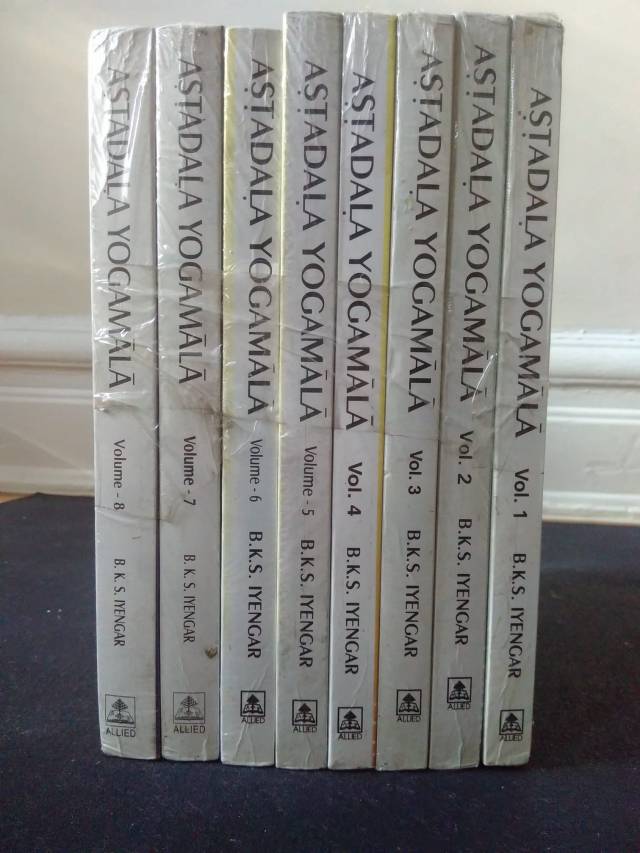Yoga is the stilling of the fluctuations of the mind.
I’ve been thinking about what yoga truly is recently, and I guess especially the state of samadhi (which I will translate here as meditative consciousness or one-pointedness of mind).
Now, when we refer to yoga or what most people think of as yoga nowadays is actually only one of the eight petals of yoga, asana, aka the postures. The eight-fold path or ashtanga yoga (not to be confused with the hatha yoga style developed by Pattabhi Jois) is often represented as a tree like below:

Credits to shaktianandayoga
But I have seen other representations such as this one:

I am personally not a fan of this second representation because it seems like it is an order in which you do things, so if you have achieved yamas and niyamas you can start asana*, once you achieve that, you start pranayama, and so on until dharana, at which point if you practice enough dhyana will happen, and if you get to dhyana often enough, then samadhi will be bestowed upon you.
Guruji BKS Iyengar has “debunked” this linear progression many times. The limbs are intertwined and you can practice every single aspect during your asana practice, for exemple during asana practice your breath should be soft and controlled like in pranayama, your awareness should be spread all throughout your body, you should not harm yourself, etc etc. I remember he also wrote about Gandhi being a prime exemple of what can be achieved with a strong ahimsa practice**, though I do not think Gandhi ever called himself a yogi. The tree imagery represent much better how the different limbs are interconnected, and it’s not like once you have roots, a tree stops growing roots to grow its trunk; on the other hand a tree keeps on growing in all directions, roots, trunk, branches, leaves, flowers and fruits, all at the same time (at least if it’s the right season ;).
Anyhow back to the topic of what I actually wanted to write about. Samadhi. I sometimes have glimpses of what I believe Samadhi must be like. This only happens to me during headstand practice, and not always, sadly. Some days I am just struggling to stay back up for 5 minutes. But some days, I manage to settle in the pose and stay there in a state of what I can only describe of effortless effort. I am lucky if this happens for a full minute. However this made me wonder about senior teachers. Though I have never met Guruji, based on what I read, I do believe that especially in his later years, he was in a constant state of samadhi, whether he was practicing asana or not. So I wonder about the senior teachers: are they in a constant state of samadhi? Do they only attain it during practice? Is what I think of as being samadhi actually samadhi? It does certainly feel like yoga in terms of cessation of the fluctuations of the mind. But then again, if I practice in a class setting I am likely to get corrected on my headstand, so is it possible to attain samadhi in a somewhat imperfect headstand? If by any chance a senior teacher (or anyone else, really, but if a senior teacher comes by, please please please comment) reads this, I would love to hear your thoughts on the topic.
Meanwhile, I finally invested on the Astadala Yogamala anthology, so I’m sure many more questions about yoga will pop up as I go through the material.

* Though I sometimes wish that yoga practitioners would “practice” yama and niyama before starting an asana practice… or at least have an idea of what it entails. So many people thinking yoga is just stretching /rantover
**I believe this was in Light on life, but might be in Tree of Yoga.
Bonus tip: I finally made it to class, and I learned this amazing tip for backbends on the chair, the one where you curve over the lean of the chair towards the wall, with your feet on the legs of the chair. While you are reaching your hands down on the wall, stop for a moment where you are, and try to sit back on the chair (without moving your hands from where they are on the wall). Then go back to walking your hands down on the wall, rinse and repeat, so that you’re basically oscillating in your backbend from more weight on your feet to more weight on your hands. Boy if that’s not a deep back opener, I don’t know what is!

I’m talking about that one, whose name I’m not sure about. I’d say Chair Urdhva Dhanurasana, but usually that refers to coming up to Urdhva Dhanurasana from having your back on the seat of the chair like for the Introductory syllabus, so if anyone knows the “proper” name please let me know below. Image courtesy of blue osa.



